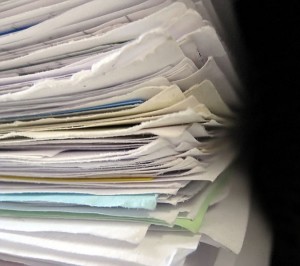
Photo courtesy of Wikimedia user Niklas Bildhauer
Some paper is thicker than others. So how do you make a comparison when discussing different thicknesses? There are two common systems paper makers and printers use: grammage and basis weight.
Grammage
Grammage measures the number of grams per square meter of paper. Typical office paper, for example, weighs about 80 grams per square meter. Sometimes this is abbreviated 80 gsm.
Basis Weight
Basis weight measures the weight in pounds of a certain number of sheets, usually 500 (one ream). As you can imagine, the size of the sheet matters when discussing the basis weight. The basis weight is usually calculated on larger sheets before they’re cut for their final application. For example, typical office paper is first produced in sheets of 17″x22″, and then cut in quarters to 8.5″x11″. One ream of 17″x22″ office paper that weighs 20 pounds is said to have a basis weight of 20 lb, even after being cut into 8.5″x11″ sheets.
Paper Thicknesses We Use at Custom Packaging & Products
When we talk to our customers, we usually use basis weight to describe differences in thickness. Our basis weights are calculated from 500 sheets of 24″x36″ paper. We then cut these sheets into smaller sizes depending on our customers’ needs.
To give you an idea, here are some basis weights of common products we sell:
20 lb – Eco Kraft Sheets
20 lb – Lightweight Deli Paper
26 lb – Heavyweight Deli Paper
40 lb – Butcher Paper
45 lb – Freezer Paper
Hopefully that helps you compare!
